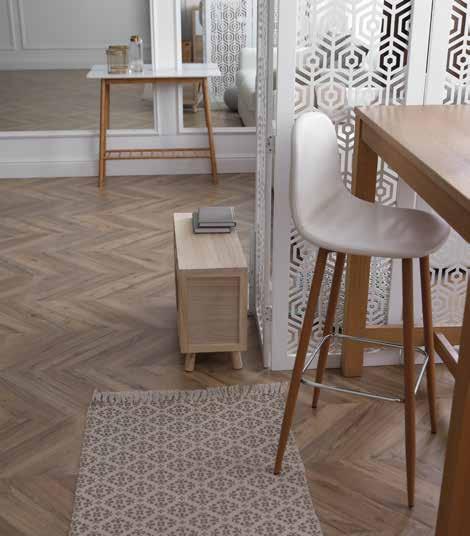
4 minute read
Not So Luxurious
by MediaEdge
Vinyl marketing claims fail to hold up when put to the test
By Dan Marvin
Advances in plastic-based flooring in the last 15 years have led to a surge in sales of this product category. Marketed as luxury vinyl tile (LVT), luxury vinyl plank (LVP) and rigid core, among other names, this type of flooring has a variety of looks that mimic tile, wood, marble and stone, and is often difficult to differentiate from the real thing. It’s advertised as a cost-effective residential and commercial flooring solution for both wet and dry areas. However, looks can be deceiving — it doesn’t perform the same as the originals. Here is a comparison of five marketing claims to test results for plastic-based flooring.
CLAIMS VERSUS REALITIES
Claim: Waterproof or water-resistant. Test: In a 2019 study at Clemson University in South Carolina, researchers used standard tests of system waterproofing to assess several popular plastic-based flooring products. The products tested allowed 12 litres per hour (l/h) to 187 l/h of water to pass through the joints of the products. By comparison, a waterproof floor would not let any appreciable amount of water through during the same test. The volume of water allowed through the joints would severely damage a typical wooden subfloor in a matter of minutes. Result: Although individual pieces of plastic-based flooring are impervious to water, the joints where these products connect to one another are not.
Claim: Use in wet areas. LVT and LVP is frequently shown being used in bathrooms, kitchens and other areas that would be walked upon while wet. Test: This claim was also examined by the Clemson University researchers by testing the wet dynamic coefficient of friction (DCOF). For hard surface flooring, a DCOF reading of 0.42 is recognized as a requirement for wet areas. In the Clemson testing, 20 of 22 samples tested failed to meet this number in at least one direction. Several
products were more slippery in one direction than they were in the other. Result: Do not use in areas where water is likely to be present.
Claim: Scratch-resistant and pet-proof. Pictures of pets walking and children roller skating on plastic-based floors are common. But a close look at the warranties of these products typically show scratching and abrasion as being excluded from the coverage. Some products go so far as to recommend furniture feet pads to protect floors. Test: The Tile Council of North America used a Mohs hardness apparatus to test several types of plastic-based flooring and found they average a three on the scale (about the hardness of a piece of chalk) versus ceramic tile that scores a seven or above (as hard as quartz). Result: Not scratch-resistant.
Claim: Mould and mildew-resistant. Test: The Clemson University study found all 25 plastic-based flooring samples had significant mould growth, some after only 24 hours of exposure to moisture. (Twenty-two of the products also specifically excluded mould damage from their warranties.) Result: Not mould and mildew-resistant. To prevent potential mould-related health effects, these products should be labelled for use in dry locations only.
Claim: Non-toxic. Result: Plastic-based flooring typically contains phthalates, organic materials known as ‘everywhere chemicals’ that must be labelled as potentially causing cancer or reproductive harm under California’s Proposition 65 requirements. These phthalates become airborne as dust particles when plastic-based flooring is abraded. The manufacture of plastic-based flooring is not above reproach either since the process is one of the last legally allowed to use asbestos, and involves perfluoralkyl substance or PFAS (known as a ‘forever chemical’ because it is very slow to break down) and mercury to create the precursors to vinyl. This type of flooring also releases a large amount of carbon dioxide into the atmosphere.
NAVIGATING ADVERTISING
While plastic-based flooring in the form of LVT, LVP and other product names has become increasingly popular, much of that is based on marketing claims that have been debunked when tested. To avoid water damage, slipping and mould growth, it should not be installed in wet areas. For improved building occupant and environmental health, natural flooring alternatives like hardwood, bamboo, stone, tile and cork flooring should be considered instead.
Dan Marvin is chair of the Tile Council of North America’s green initiative committee. In this capacity, Dan has developed multi-attribute sustainability standards for the tile industry, industry average environmental product declarations for tile and installation products, and a material ingredient guide for tile materials. He also frequently speaks on sustainability topics at flooring industry events.
PREMIUM
We've got you covered.

PERFORMANCE
Industry-proven waterproofi ng and crack isolation A-10140-0322 ©2022 LATICRETE International, Inc. All trademarks shown are the intellectual properties of their respective owners. *See applicable product Data Sheets for complete installation instructions including fl ood testing. ^Steam room/steam shower usage applies to HYDRO BAN® XP only. protection for any application. We provide best-in-class See Data Sheet 025.0 for complete warranty information. waterproofi ng and crack isolation protection for showers, pools or spas, steam showers^ and steam rooms^ .
NEW! NEW!
25 YEAR WARRANTY
Complies with ICC-ES ESR-2417








